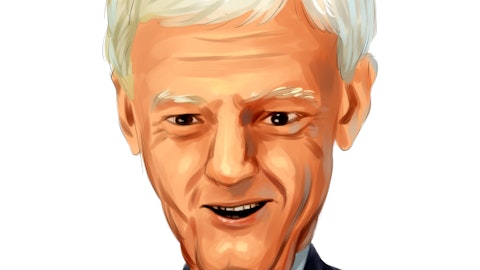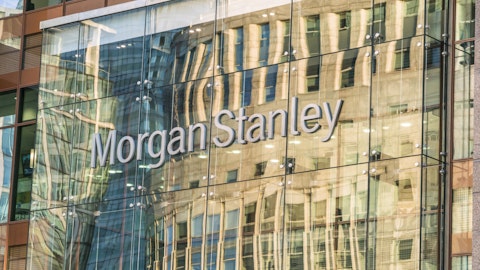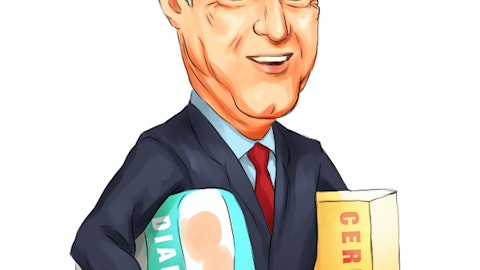Mike Mayo: The more important question would just be your medium-term target to take your returns to 23% up from 21% last year, I guess, 21.5% or so this past year. How do you define the medium-term? And for that 150 basis point increase from here, how would you segment that like it efficiency, revenues, buybacks or some other way just to give us like a simple waterfall chart inwards?
Dermot McDonogh: So the way I would think about it, Mike, is, you know not to give you a kind of a weak answer really is all-of-the-above. And if you think about fee revenue, we’re very focused on higher organic growth, and we said about that and we’ve made a lot of mention about the Chief Commercial Officer, one BNY Mellon and kind of just generally de-siloing the organization. And we really feel optimistic about being able to deliver over time higher organic growth. Also in 2023, you know FX volumes around the world and volatility was lower and so we expect FX revenue that to normalize, which give us a boost. And look, we kind of — we’re optimistic about where equity markets are going to go. And so in our plans, we have mid-single-digit equity market appreciation to support that fee revenue growth.
On expenses, look, I think 2023 was a year where we got 50 plus thousand employees on the same page as how Robin and I think about and the management team think about running our company better. We don’t talk about cost-cutting or you know headcount layoffs. We talk about what are the things that we need to do to run this company better. And I think we have 50,000 people aligned with us now and I feel very optimistic through all the projects that we have underway to digitize the firm, automate processes, deliver more for our clients so everything we’ll feel together and will do a lot at the same time. And with all of that, be able to buy back more stock, which will drive us to that higher ROTCE and pre-tax margin that you talked about.
Robin Vince: And Mike, I would just add one thing to that, which is we talked at the beginning of 2023, and you pressed us on this and rightly so in 2023, about the fact that we hadn’t before managed to tell the improved expense story that we think we actually ended up tailing on in 2023, and that was an important focus. We also recognize that we were likely to have a good NII year and we took the opportunity of those two things to be able to invest for future fee growth. We never thought 2023 was likely to be a very strong fee year because the fees take time to be able to generate the return from the investment that we’re putting into it through the various different things that Dermot just detailed. And so we’ve set ourselves up, we think to now be able to really leverage those investments and that’s a 2024, 2025, 2026 story.
Now, of course, we will stay focused on NII. We’ll absolutely stay focused on efficiencies and expenses. We think AI will play a story in that over time, probably not a short-term story, but more of a medium-term story, and that’s how the whole thing comes together from an operating leverage point of view. So the way we got there in 2023 is probably going to be different than the way we’ll get there in 2024. We’re trying to point you to that through the disclosures.
Mike Mayo: Thank you.
Robin Vince: Thank you.
Operator: Our next question comes from the line of Brian Bedell with Deutsche Bank. Please go ahead.
Brian Bedell: Great. Thanks. Good afternoon, folks. Thanks for taking my questions. Again, also, thanks for all the detail around the businesses and long-term outlook as well. If I can focus on Slide 16 in the securities servicing goals there. How do you think about you know in terms of automating the processes, the first two boxes that drive the cost-to-serve down and then the second one on deepening client relationships? How do you think about the effect of digitizing and automating these processes? And whether sort of matching that against — you know to what extent you can actually enhance the revenue profile as well? Or are you favoring lowering the cost and not so much enhancing the revenue profile by digitizing the services? Or is there two parts of that where you can also improve the servicing quality?
Dermot McDonogh: Okay. So here’s how I would answer that, Brian. So we’ve — and I said in my prepared remarks, we’ve made a loss of through last year and this year in the budget process. We have made a lot of investments in our foundational infrastructure that supports the asset servicing business. And so that’s going to result in greater automation and a better client experience. We hired a new Head of Operations last year, and he’s made a tremendous impact and we’re spending a lot of time with our clients through understanding client behaviors where they’re able to explain to us what they need and we can then figure out how to change our processes to be more to be automated to deliver their solutions. So we’ve made a lot of good progress there.
So through driving down the cost-to-serve, we’re going to give better client experience, which will then ultimately lead to enhanced revenue and enhanced client experience because the clients will be happy with us. The other thing I would say is for asset serving specifically. We had our strongest sales quarter in 2023. We come into 2024 with a very healthy uninstalled book of business and we feel very good about the mandates we won in Q4, and we feel very good about the pipeline coming into 2024. So I feel very, very good about all the leadership changes that we’ve made in asset servicing over the last 12 months, the hires we’ve made and the impact that they’ve made since they’ve joined. And then within the other part of Securities Services, corporate trust and depositary receipts.
We’re making significant investments in corporate trust this year to do a lot more digitization and a lot more automation so we can scale the business and drive that margin higher.
Brian Bedell: That’s a great color. And then just a follow-on on the balance sheet deposit beta and the Fed cuts and maybe if you can also comment on international cuts from the Bank of England and ECB. How are you viewing your deposit beta on the downside? Do you think within your guidance are you able to move that down commensurately? Or is there a significant lag and does that differ between the US and Europe?
Dermot McDonogh: So just to kind of give you a general framework. Nothing really has much changed quarter-over-quarter. The dollar bulk, which is roughly 75% of the overall portfolio has an 80% beta. As I’ve said many times, we have sophisticated clients. They’re with us for not just deposits but for a variety of goods and services which feeds the stickiness of our overall deposits being two-thirds operational. So that’s a good story. We passed on the prices. As I’ve said, we — it will grind a little bit higher from here, but I think I feel pretty good about the dollar book on where that’s at. And then euros and sterling, which make up the balance into 55 to 65 base range. And so as the Fed kind of ultimately will pivot and rates will come down, we do expect that to follow symmetrically and so go downward the same way it came up. So that’s how I would view that.





